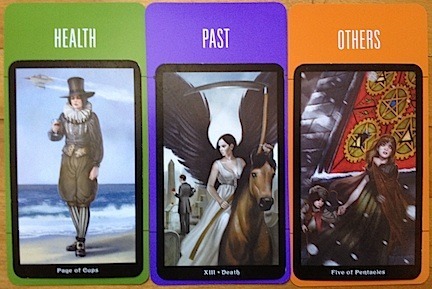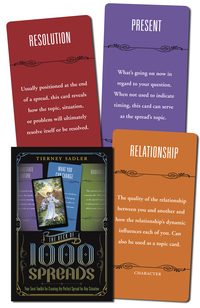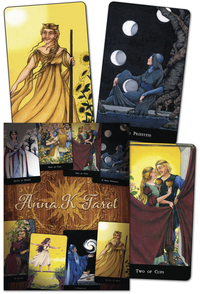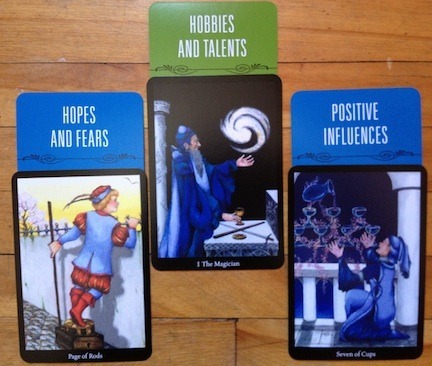Llewellyn Publications's Blog, page 94
March 27, 2013
New Items from Lo Scarabeo
Yesterday I got to see some new items from Lo Scarabeo that will be available in the US very soon.
Lo Scarabeo creates innovative tarot and oracle decks. They also make many other items that are of interest to tarot enthusiasts, such as bags and reading cloths.
I am particularly excited about their newest reading cloth. It is large (47 x 31 inches), rich dark blue velvet, with a small very light grey satin border and tassels. I like it because there is no design in the center to interfere with my cards.
See more about the cloth HERE
There are three new bags, one featuring art from the much anticipated Illuminati Tarot, one with the Universal Tarot Magician, and one with art from the forthcoming Dragon Tarot.
For those who like to write letters the old-fashioned way or use writing techniques in their magical work, the new sealing wax and seals will be of interest. I know I’m looking forward to working with them. There are three designs.
March 25, 2013
The Futility of Fault
Recently, Nick Farrell blogged on why he believes magical rituals fail. Whether you agree with it or not I think you will find it interesting.
One aspect that is not mentioned there is that it assumes magick works. I agree. Therefore, if it doesn’t work, there must be a reason. If you worked by yourself, you were obviously at fault for the failure. If you worked with a group, you or someone else, or perhaps several people were at fault for the behavior.
Understanding magickal theory and then analyzing what happened during and following a failed ritual is certainly important. However, saying that you or someone was at fault for the failure is ultimately not only useless, it can also make future success more difficult.
What Happens When Fault and Blame are Assigned
Years ago, I had a girlfriend who had two daughters in their early teens. I was living near the beach and they all came over to spend a weekend near the ocean. The two daughters took a bath together. Later, when I went into the bathroom, the floor was sopping wet—almost flooded—next to the bathtub.
The next morning, at breakfast, I said, “Listen. Last night, after you girls took a bath, their was a lot of water spilled over the side…”
Before I could finish, the two girls started denying they had done anything and blamed it on the other girl.
“Whoa,” I said. “Hold on. Nobody’s in trouble. There’s no blame here. It doesn’t matter who did it. Maybe I did it. I just wanted to ask you both to make sure you keep the water in the tub. Okay?”
They looked at each other, sort of flabbergasted. In our world today, it seems that when something goes wrong, people expect to experience blame and immediately need to defend themselves.
We’ve all been blamed for something at some time. We’ve all be told that we’re at fault. Generally, the response to such attacks is defensiveness, either by denying that we’re at fault or assigning the blame to someone else or to unavoidable circumstances.
Inwardly, the feeling can be horrible:
People blame me for something going wrong!
They don’t trust me.
I’m not the one who did it, s/he did it!
It wasn’t my fault! I couldn’t help it.
An example of this that is very funny because it rings so true was when Jake, played by John Belushi in “The Blues Brothers” movie, gave a list of excuses for failing to marry his fiancé. You can see it HERE.
Think back to a time when you’ve been accused of being a fault for something. How did you feel? The next time you try to do that same action or set of actions, it will bring back those same feelings. Holding on to those feelings will simply result in negativity toward success or perhaps a tentativeness in action with a focus on not doing anything wrong rather than on performing the ritual correctly. Either aspect—negativity toward the ritual or people you’re working with or a focus on not failing rather than succeeding—may prevent your magick from working.
Shift from Finding Fault to Finding Solutions
Earlier, I wrote “analyzing what happened during and following a failed ritual is certainly important.” But if you’re not going to use this group analysis (if the ritual involved others) or self-analysis (if you performed the ritual solo) to find out who or what was at fault for failure, why do it at all?
Many years ago I bought a small book called Zen Comics. It had numerous one-page comics illustrating Zen parables. One that I always remembered showed a teacher and his student in a rowboat. Another boat comes their way and smashes into them. The student yells insults at the person rowing the other boat for having poor boating skills. The two boats go their separate ways and a bit later the teacher finally speaks, asking the student, “If nobody had been in that other boat, who would you have yelled at?”
Blame and fault are not needed in magick. If a ritual fails, it doesn’t matter who was at fault. What matters is making sure that whatever prevented the magick from succeeding doesn’t happen again. If there is a group working and one of the ritualists was telling jokes, there’s no reason to call him or her out. If you just find fault with the joke teller, the next time someone else might interrupt the flow of the ritual by telling a joke or talking about something extraneous to the ritual. The problem isn’t the person, it’s the behavior. Therefore, instead of saying, “John, you spoiled the ritual with all your jokes,” a better response would be,”The ritual didn’t work because we really didn’t focus on what we were doing. In order to have success, we need to be more attentive to the work of the magickal rite, and we can do that by being committed to achieving X, Y, and Z.”
Note, too, that the approach is positive: This is what we should do as opposed to this is what we must not do. Why? Because if your attention is on what you don’t want to do when you’re performing the ritual, when you start the ritual you’ll be focusing on what to avoid rather than on the actual ritual work.
Forget about fault.
Forget about blame.
Focus on solutions.
Achieve magickal success!
March 21, 2013
Letting the Cards Shape the Question
Today I am again playing with cards, just as I did the other day HERE.
I am again using the Deck of 1000 Spreads but today I’m also using the Steampunk Tarot.
There has been a lot of change in the day to day things of my life. Nothing huge, just mundane stuff, like joining a new gym (after having been with my old one for about 3 years) and switching to cable after being with satellite for 10 years. Through most of my life, such changes were nothing. I always adapted easily. But lately, I feel stubborn and weird about changes, even if they are good ones.
Today I asked why I am being this way. I randomly pulled three cards from the Deck of 1000 Spreads to create the positions, then shuffled and drew randomly fro the Steampunk. Here is my reading:
The Health card (the text on the card hidden by the Page of Cups) says that this position can be either physical or emotional health. So apparently I am being a big, emotional baby, which certainly feels true.
In the Past position, I have Death. In the past, I loved the change that Death brought. I embraced it and loved moving on, recreating myself and my life. But there was always a sense of a total cut, a total separation.
So what do I make of the 5 of Pents in the “others” positions? The text on the Others card says it can be others or society in general. I think it is because I associate the changes with lack, since several of them are because of financial decisions.
I love my life. But I am acting like a big baby who thinks that these changes are reflecting a life that is “less than.” I am forgetting the reason for the changes, which have more to do with improving my lifestyle in ways that prioritize things other than money.
There is much more to all this and sharing personal readings are difficult. I think, though, that I’ve shared enough to illustrate my main point, which is Tarot rocks and the Deck of 1000 Spreads rocks right along with it. It helps me ask the questions that need to be asked, in ways they need to be asked, even if I don’t consciously know what they are…until the cards are revealed.
Magick is a Science: Treat it that Way!
Two days ago was the Spring Equinox. The Sun was exactly overhead at noon. This solar influence has been so important on the history of humanity that it is celebrated in numerous cultures going back thousands of years. Zoroastrians call it Nowruz. Jews identified it with Pesach (Passover). Some Pagans associated it with the goddess Eostre and Christians adopted the name and timing for Easter. Some Pagans call it Ostara, Other pre-Christian names include Alban Eilir and Bacchanalia. Some refer to it as Lady Day and many consider it the start of the new year.
Billions of people have considered this time the end of the cold darkness of winter. Life is returning and plants begin to show leaves and animals begin to have new births. The darkness ends; the light begins. Warmth begins to fill us. It’s time to have a spring cleaning in the house—open the windows and get rid of the accumulated dust, dirt, and cobwebs of winter.
That goes for your physical home, your school or place of work, and your most personal and private house, your mind. It’s time for a change.
A Question I Frequently Receive
In a recent post, Patti Wigington responded to a question: “Can I use this wand?” Actually, she reports, she had received this question a year ago, but just received a similar question.
The particular wand in question is a molded hunk of plastic, so her response is that because it is “synthetic object,” in “some” cases it is “is not conducive to spellwork.” This immediately leads to my question, “How do you know which magick it’s not appropriate for?” Her solution: “…give it a whirl and see how it works out for you.”
I think I may know how Patti feels. When I started teach b.i. (Before the Internet), I would receive (snail) mail with questions like this all the time. Today such mail has trickled down to almost nothing. Instead, I receive similar questions via email.
Can I use this wand?
Can I change the ritual this way?
Can I use a paper cup instead of a chalice?
Can I incorporate this exercise?
Can I use this color scheme?
Can I hold the dagger this way?
Can I use a different divination system?
Is it okay to use this Tarot deck?
All of these questions are asked honestly. Most often, they’re asked by someone relatively new to magick. I understand. For the past few months I’ve become an acquisitions editor for Llewellyn* and one of my responsibilities is entering information about new manuscripts into Llewellyn’s computers. I still feel insecure about it because I’ve only done it three times and I ask questions to find out if I’m doing it right.
But there’s a slight difference, here. I make the entry and ask if I’ve done everything correctly. I try, then ask for feedback. The people who ask the questions above, like the people who asked the same type of question to Patti Wigington, hadn’t tried anything. They wanted approval first. Part of this is natural, neophyte insecurity. But there is also an implied idea that the techniques of magick are more of a religion than a science. They are written in stone, never to be changed, and people with a little experience, such as myself, or those with far greater experience and fame, such as Israel Regardie or MacGregor Mathers or Aleister Crowley are magick’s interpreter/priests who, like astral Popes, can give authority to use a plastic wand or paper cup. I have to let you know the following:
• We can’t give you the authority to use a non-standard magickal tool.
• We aren’t interpreter/priests.
• The rules of magick are not written in stone.
• Magick is not a religion.
Magick is a Science
One of the descriptions of magick is that it is an art and a science. This is often interpreted to mean that people can have innate magickal skills, like a natural-born artist, and magick can be a learned skill, much as being a chemist is a learned skill. But there is another aspect of science that is important, perhaps best exemplified by this quote from the late astronomer Carl Sagan:
In Science it often happens that scientists say, “You know, that’s a really good argument. My position is mistaken,” and then they would actually change their minds and you never hear that old view from them again. They really do it. It doesn’t happen as often as it should because scientists are human, and change is sometimes painful. But it happens every day. I cannot recall the last time something like that happened in politics or religion.
The implication here is that science is not written in stone. Ideas about scientific concepts change. How do such concepts change? Because experimentation leads to new conclusions. So because I contend that magick is scientific, the response I give to the questions above is usually, “Try it. If it works, use it. If it doesn’t work, try something else.”
I have been criticized for this scientific approach to magick. If my approach is accurate, a few people say, then all of the books and traditions of magick are meaningless. You just do whatever you like and if it works, you use it. So why have any books at all?
To those who criticize this approach, calm your jets! There’s a powerful reason to study and practice what’s in various traditions and use the traditional methods: they’ve been tested over time and, for thousands of people, they work. Most people who diligently use them will have success. Some will not. If, after diligent practice you still aren’t succeeding, it’s important to try something else.
That’s the way science works. Prescription drugs have saved hundreds of millions of lives. Some drugs, however, only work on a small majority of people. That means for many people a particular drug is ineffective. Doctors don’t keep prescribing the same drug thinking that it will eventually work (well, effective doctors don’t do this). Instead, they look to alternative drugs and treatments.
Similarly, the magick that is taught in those books that have stood the test of time and the classic systems shared by teachers** are effective for most people. But if they don’t work for you, try something else. If you have access to something other than what is in the book or shared by a teacher, try it. If it works, use it. If it doesn’t work, go back to the tradition.
My saying that people should try alternatives and see if they work does not mean to abandon what others have done before. Rather, it means we should learn the science and help develop it further.
Treat Magick Like a Science
I think all magicians go through periods where they wonder, “Can I alter a ritual this way?” or “Can I use this very non-traditional tool?” As we enter a new spring season and clear out the cob webs, I would encourage you to think as a magickal scientist.
What if there were no books?
What if there were no interpreters of supposed rules?
What would you do?
EXPERIMENT!
Try the changes. Try the different tools. Keep records. See my previous post on this. If new things work, use them. If they don’t work or aren’t as effective as you’d like, go back to the tradition. This is the way to become a magician/scientist. This is the way magick will advance.
Happy Vernal Equinox
*I’m now an acquisition editor for Magic(k) and Occult Topics. Do you have manuscript or idea for a book? Email me: [email protected]
**Some teachers create unique systems that work for them but may not work for many others. Unfortunately, some of those teachers don’t understand this, instead presenting their system as the real, previously secret, most powerful, etc., etc., system of magick while they denounce all others. They make the mistake of assuming that the specific (that their system works for them) can move over to the general (this system should, therefore, work for everyone) without any evidence to support this. Even worse, because some of them can’t stand the idea that their system is not the only system of magick that works, they may attack what others do. This may lead to ego inflation, instigating us vs. them fights, and the accumulation of a small, personality cult following.
March 20, 2013
Sun Enters Aries 2013: Forecast for the Year Ahead
Aries, The Ram
March 20 to April 19
Modality: Cardinal
Element: Fire
Ruler: Mars
Keywords: Initiative, action, adventurous, enthusiastic, dynamic, impatient
As an Aries you are a born leader, eager to take the initiative and be a leader. Be careful, though, as you tend to be impatient; this trait can get the better of you at times. You are energetic, and fiery Mars ensures that you are good at what you try. Sports and exercise for you are relaxing and help you free your mind.
You have a wide social circle, though it is mostly comprised of acquaintances, rather than close friends. Your love life is nurtured by your energy and enthusiasm, which is helpful being that you place a lot of value on relationships and partnerships. You likely have a strong need for children, but be careful that you don’t dote too much on your kids. Be sure to spend your time (not your money) on them.
Your enthusiasm and motivation translates well to your career, and you are mindful to keep moving up the ladder. You excel at analysis with an eye for detail; be sure that your impatience doesn’t hinder your good career prospects. You have excellent earning potential and can do well with long-term investments; make sure that you look before you leap when diving into a large financial risk. You are frugal and understand value.
For the year ahead:
Affirmation: Patience brings opportunity.
Jupiter spends the first half of 2013 in your third house (gemini). Your social schedule will likely be very full, and you may find yourself becoming more involved with community pursuits. Jupiter moves into Cancer on June 25; the latter half of this year, you will see your focus shift to family, home, and other domestic concerns. This transit is good for organization and home repairs.
Saturn continues its course through Scorpio (your eighth house of joint resources) since October 2012. This is a great time to pay down debt and examine your family spending, saving, and budgeting.
Uranus again spends the year in your sign (it remains in Aries until 2018). You may feel a new, more independent side of your self emerging.
Pluto is now in its fourth year in Capricorn, your tenth house, and continues its powerful influence on career during its long transit (lasting until 2024). This placement can help you achieve ambitious career goals, but it can also signify trouble at work (think personality clashes or downsizing). With Pluto in your tenth house, be aware of what is going on at your workplace.
March 19, 2013
Playing with New Decks
Today I needed to play, so I selected the Deck of a 1000 Spreads and the forthcoming Anna.K Tarot (available May 2013, but you can pre-order it!)
Do you ever have those times when you want to play with your cards but don’t have a question to ask? The Deck of 1000 Spreads is great for that.
I shuffled the deck and randomly drew three cards to create the spread. I trusted them to know what I most needed to know right now. I got: Hobbies & Talents, Hopes & Fears, and Positive Influences.
I laid them out, shuffled my Anna.K and drew three cards.
Tarot, as usual, always seems to know what is needed. I’ve been wondering a lot about my career, whether to expand into other areas or stick with my area of expertise. The Magician says to focus on mastery but also indicates that I can master whatever I want.
The Page of Wands addresses my Hopes & Fears very well. My fears include wondering if I will have fresh, exciting new ideas to keep me interested in my work. My hopes are just that: that I always learn and explore and never become stale.
The 7 of Cups has never been a favorite of mine, since I prefer to be grounded in reality and very focused (like a good Capricorn). Normally this card is not the most positive, often indicating a disconnect between perception and reality. But it can also mean dreaming and fantasizing, which can be either positive or negative. Since it is in the Positive Influences position, this reading is telling me to address my fears (and support my hopes) by actively dreaming, thinking about things that I haven’t before or in ways I haven’t. It also reassures me that times of what I may call “non-productivity” are actually productive in their way, and are part of the creative process that keeps my work lively and interesting.
Here’s a picture of the Anna.K cards and the book. It’s going to be such a nice little package.
International Astrology Day is Wednesday, March 20, 2013
Tomorrow is International Astrology Day!
Considered by many to be the start of the astrological new year, International Astrology Day is celebrated each year on the Spring Equinox (the day the Sun enters Aries). There are various observances around the world, including lectures and other events.
Anyone have any plans to celebrate this observance?
Never Letting Go Author Mark Anthony on Coast to Coast AM, Saturday, March 16
 Mark Anthony, psychic lawyer and author of Never Letting Go, was a featured guest on Coast to Coast AM on Saturday (3/16/13). During the show he discussed consciousness, death, and the afterlife. Click here to listen to the full show.
Mark Anthony, psychic lawyer and author of Never Letting Go, was a featured guest on Coast to Coast AM on Saturday (3/16/13). During the show he discussed consciousness, death, and the afterlife. Click here to listen to the full show.
Coast to Coast AM is the #1 radio show in the US, airing nationwide on over 500 affiliates and with a combined audience of over 17 million people. The show airs from 10pm—2am Pacific time; it is the most listened to overnight radio program in North America. Visit http://www.coasttocoastam.com/affiliates to find a radio station near you that airs the program.
Witches, Faeries, and the Devil
Readers, please enjoy this guest blog post by Cassandra Eason, author of Angel Magic and the new Magick of Faeries.
 The superstitious belief that Witches made pacts with the Devil was well documented during the Witchcraft trials of the late fifteenth to seventeenth centuries in Western Europe and Scandinavia. A number of Witchcraft trials, particularly in Scotland in the late 1500s and 1600s, also implicated faeries as both servants of the devil and teaching Witches (mainly women) their magical arts. To the clergy, both Witches and faeries were equally associated with demonology and thus considered evil.
The superstitious belief that Witches made pacts with the Devil was well documented during the Witchcraft trials of the late fifteenth to seventeenth centuries in Western Europe and Scandinavia. A number of Witchcraft trials, particularly in Scotland in the late 1500s and 1600s, also implicated faeries as both servants of the devil and teaching Witches (mainly women) their magical arts. To the clergy, both Witches and faeries were equally associated with demonology and thus considered evil.
Isobel Gowdie, The Faery’s Friend
In 1662, Isobel Gowdie from Nairn, in the Moray Firth, made four separate confessions of Witchcraft, all entirely voluntary. She claimed she had the power to shapeshift into a hare, a crow, and a cat. The following spell to become a cat, quoted by Isobel in her trial, has passed into folk rhyme; when I taught in Scotland more than thirty years ago children chanted a version of it as a playground skipping game, substituting Lord for the Devil’s name.
I shall goe intill ane catt,
With sorrow, and sych, and a blak shott;
And I sall goe in the Divellis nam,
Ay will I com hom againe.
Isobel recounted meeting the Queen of Faeries and visiting Faeryland, how “The hills opened and we came to a large and braw room—and there I got meat from the Queen of the Faerie, more than I could eat. The Queen of the Faerie is brawly clothed in white linens, and the King of the Faerie is a braw man, well-favoured and broad-faced.”
Isobel alleged that she witnessed the Devil himself in faeryland making poisoned elf bolts, the legendary flint arrows that were shot without bows. She also described fearsome faery bulls.
Isobel was initiated, she told the Inquisitors, by a grey man dressed in black, a faery devil—a “meikle, roch. Blak man, cloven footed.” Isobel spoke of the faery devils who led other local covens, but they were dressed she said in yellow and green.
It is possible that Isobel did attend some local gathering of nature worshipers to celebrate the old agricultural and fertility festivals, and the grey man could have been an actual coven master. He may have been a respectable local figure who was sympathetic to the old ways, but obviously disguised and maybe masked and with the Horned God antlers during coven meetings. The wild sexual practices described by many Witches were probably partly reflecting the sexual frustrations and fantasies of the Inquisitors and the actual sexual nature of some of the festivals where people did make love. Perhaps on occasion a better educated coven master took advantage of the simple and maybe excited women. Certainly Isobel was very sexually frustrated by her apparently passionless husband.
But, there was undoubtedly in the fifteen to seventeenth centuries, and even beyond, a huge overlap between the beliefs in faery worlds, Witchcraft, and what were perceived as demonic figures, but that may have been survival rituals from the old, watered-down Pagan Horned God religion. These accounts reveal not only astounding prejudice against the paranormal but how among ordinary folks, the fey co-existed as part of a world where magick was the reality and not the illusion.
Our thanks to Cassandra for her guest post! For more from Cassandra Eason, read her article “Faeries and Love.”
March 18, 2013
Discovering Tarot: Learn From the Old—Create the New
There is more than one mythic history of the Tarot. It’s important to note that by mythic I don’t simply mean that the stories were made up and imaginary. Rather, myths are information conveyed in a story to indicate the importance of something. Aesop’s fables, for example, are myths explaining timeless truths in simple stories.
Although the Tarot has been used for hundreds of years, its active use as part of ceremonial magick really only dates back to the late 19th century. The key to this was the linking of the Tarot to the Kabalistic Tree of Life. This first appeared in print in an article by the Comte de Mellet in the 1781 book, Le Monde Primitif by Court de Gébelin, which noted that the number of paths on the Tree of Life matched the number of cards in the 5th suit of the Tarot. (One source claimed calling it the Major Arcana was created by Paul Christian, the pen name of Jean Baptiste Pitois in his book, The History and Practice of Magic, originally published in 1870. However I don’t think this is accurate as the timing is off.)
This was picked up by Eliphas Levi, who developed an initial system of correspondences between the Tarot and the Tree of Life. Levi was one of the leading lights of what has been called the French Occult Revival of the middle to end of the 19th century. Numerous mystical and magical Orders developed during this time, finally crossing the English Channel and resulting in the births of groups such as the Theosophical Society and the Hermetic Order of the Golden Dawn (although there may have been predecessors to the latter). The Golden Dawn changed Levi’s system to match their concepts. Aleister Crowley modified this a bit to meet his system. Frater Achad (Charles Stansfeld Jones) made some revolutionary changes, too, but these have been adopted by few people.
The bottom line is that today, Western ceremonial magick and the Tarot are intricately intertwined. Therefore, it makes sense to study the Tarot for more than one purpose.
Why the Tarot?
The images on the Tarot are mythic and symbolic. Working with them, especially in meditation (such as described in Modern Magick ), can help open your intuition.
The Tarot can be a building block, a basis for understanding various correspondences used in magick.
The Tarot can be used as an entry into the astral plane and Kabalistic Pathworking.
The Tarot can be used as a guideline to spiritual development.
And of course, the Tarot can be used for divination.
When most people start with the Tarot their purpose is to learn divination. That’s why I started to learn the Tarot. In my previous post I stated that I don’t think you should throw out the little booklet that comes with Tarot decks. Rather, you can use the books that come with the Tarot as a basis for learning more about the deck.
Even so, learning the Tarot can be daunting. You have 78 sometimes complex images to memorize, followed by learning about their interactions between each other and with the positions where you lay out the cards in a spread. This means there are many hundreds of thousands of potential meanings for the cards.
When you look at it this way, it’s kind of scary. How can you possibly learn all of those meanings? In NLP we call this being chunked up—only seeing all of those cards and their meanings as one impossible-to-learn whole. But we can chunk down and look at only a little at a time. We can begin by looking at the meaning of just one card. When we understand it we can expand our studies to the next card and continue in this pattern. Using this one-at-a-time method, the seemingly huge amount of information becomes smaller, bite-sized pieces that are easier to digest and learn.
This, however, brings up another, even more basic question: How do we learn?
Two Learning Methodologies
A little over a decade ago I spent time helping teach computer graphics at the University of Southern California (USC). One of the head instructors insisted that the students learn what the filters do in the application Adobe Photoshop by first applying them to an image. After the students saw the effect of the image, she would instruct on what the filters theoretically do.
This is a natural approach for a graphics professional. Use your eyes and see what happens. From there you can use deductive reasoning to understand what you see.
One student, however, absolutely refused to do this. He insisted on learning what the concepts of each filter were before he applied it to an image (the image was that of a rubber duck that came with the application). Only after he understood the inner functions of how the filter worked would he want to see what it did. This is more along the line of what is called inductive reasoning.
In fact, deductive (starting with the general and moving to the specifics) and inductive (starting at the specifics and coming to a general idea) are descriptive of the two major ways people learn. If you naturally learn one way and are being forced in school to try and learn the other way, you will have a difficult time. Many children who just have a different learning methodology and are labeled poor students are actually quite bright and merely don’t have teachers who can present information in a way where the student can learn.
How I Learned the Tarot
When I first decided to learn the Tarot, I purchased three popular books on the subject. I figured I could simply absorb their different approaches, merge the information, and become a Tarot reader. Unfortunately, all three books gave decidedly different information. My plan failed.
Next, I took a mail-order course from a group called The Associated Readers Of Tarot (the acronym of their name is TAROT). Although they are no longer around, they presented a system from which I could base my future learning. I learned each card and put it into a whole, then I expanded it. One way I expanded on this was to take the training from Paul Foster Case’s Builders of the Adytum (BOTA), a Golden Dawn derived group that has a major focus on the Tarot.
There were two books, both now out of print, that deeply influenced my advanced learning. This was not because they gave some inner secrets, but because they gave an approach that allowed my mind to have greater understanding.
The first was Dictionary of the Tarot by Bill Butler. In this book the author took each card and showed what a variety of authors gave for their meanings. Then he gave his own meaning which was supposed to be based on the other sources, but often seemed to have nothing to do with them. Although I still laugh at this, his approach triggered my concept of collecting the ideas of others, blending them, and coming up with my interpretation based on those ideas. However, I still felt limited and I didn’t know why. I didn’t “get” that I needed to add my own ideas and intuition.
The second book was Tarotmania (I think this was a terrible name for a good book*) by Jan Woudhuysen. On her website she writes,
This is the original Tarotmania book that I wrote in 1979 as a protest against all the mystical back-to-the- Egyptians books that explain the tarot cards. As far as I am concerned, I don’t believe in tarot cards, I just make use of the cards to find out what’s going on.
What I especially liked about her book was her way of organizing information. She made a chart (1979 was before the popularity of computer spreadsheets) with the name of each card in a column on the left and the name of each source a row going across the top. Thus, by simply looking down and across the sheet (as I recall, she suggested using large sheets of paper and pasting them on the wall) you could see the meanings given to each card by an authority. Then in the last box of the row, you could use your intuition combined with the information to come up with your own meaning of the card.
Your meaning may or may not agree with some or any of the experts, but it is your meaning. It can be just as valid as that of any authority if, in practice, your meaning is shown to be accurate.
There is no doubt that if you’re “chunked up,” learning something such as the Tarot, the Runes, astrology, or another divination system can seem like a difficult challenge. But if you determine your learning style—inductive or deductive—and “chunk down,” learning any of these powerful tools can become an adventure of spiritual self-empowerment.
*It was also published under the title Tarotherapy—still, in my opinion, not a great or appropriate name.
Llewellyn Publications's Blog
- Llewellyn Publications's profile
- 241 followers












